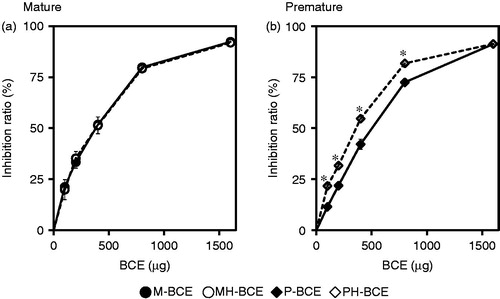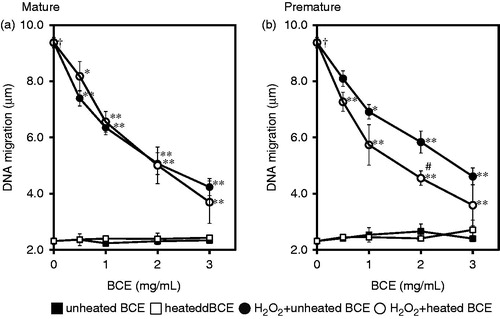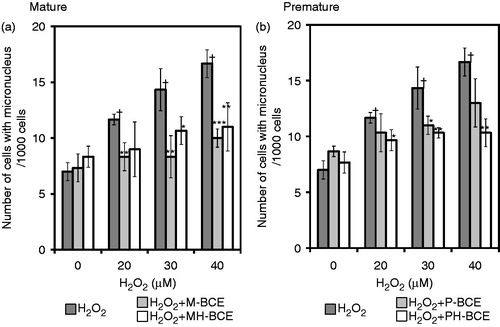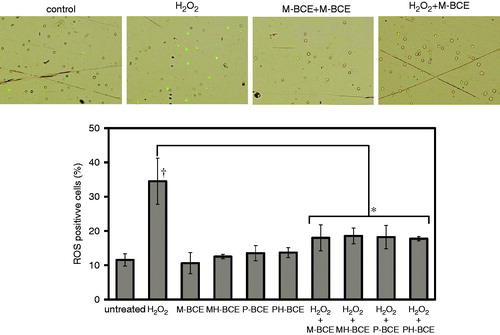Figures & data
Figure 1. DPPH free radical scavenging activity of BCEs. The ordinate axis indicates the ratio of inhibition of DPPH radicals. In this experiment, 0.016% of DPPH reaction solution and 0 to 1.6 mg of blackcurrant extract from mature fruit (filled circle), heated-mature fruit (opened circle), premature fruit (filled diamond) and heated-premature fruit (opened diamond) were used. Each symbol represents the mean value of three experiments. An asterisk (*) indicates p < 0.05 in the t-test comparing P-BCE and PH-BCE.

Figure 2. Effects of BCEs on H2O2-induced DNA damage (DNA migration) in human lymphoblastoid TK6 cells. The effects of BCE extracted from mature fruit (a) and premature fruit (b) are separately presented. In this experiment, 0 to 3.0 mg/mL of blackcurrant extract was treated without or with 300 µM of H2O2. Filled square, unheated blackcurrant fruit without H2O2-treatment; Opened square without H2O2-treatment; Filled circle, unheated blackcurrant fruit with H2O2-treatment; Opened circle, heated blackcurrant fruit with H2O2-treatment. Each symbol represents the mean value of three experiments. A dagger (†) indicates p < 0.00005 in the t-test comparing H2O2-treated (300 μM) and untreated cells. A number sign (#) indicate p < 0.05 in the t-test comparing P-BCE and PH-BCE. An asterisk (*) and two asterisks (**) indicate p < 0.05 and p < 0.005, respectively, in the t-test comparing H2O2-treated and H2O2 + BCE-treated cells.

Figure 3. Effects of BCEs on H2O2-induced chromosomal aberration (micronucleus formation) in human lymphoblastoid TK6 cells. The effects of BCE extracted from mature fruit (a) and premature fruit (b) are separately presented. Dark gray column, H2O2 single treatment; Light gray column, H2O2 treatment combined with unheated blackcurrant extract; White column, H2O2 treatment combined with heated blackcurrant extract. Each column represents the average of three experiments. A dagger (†) indicates p < 0.005 in the t-test comparing H2O2-treated (20, 30, 40 μM) and untreated cells. An asterisk (*), two asterisks (**) and three asterisks (***) indicate p < 0.1, p < 0.05 and p < 0.005, respectively, in the t-test comparing H2O2-treated and H2O2 + BCE (1.0 mg)-treated cells.

Figure 4. Intracellular ROS scavenging activity of BCE. Intracellular ROS was measured using BES-H2O2-Ac fluorescent probe. H2O2-induced ROS was reduced by BCE (1.0 mg/mL). The ROS-positive cells more than 100 were counted in each treatment. A dagger (†) indicates p < 0.05 in the t-test comparing H2O2-treated (300 μM) and untreated cells. An asterisk (*) indicate p < 0.05 in the t-test comparing H2O2-treated and H2O2 + BCE-treated cells.

Table 1. Total polyphenols, anthocyanins and l-ascorbic acid content in the BCEs.
